Abstract
OBJECTIVE--To determine the role of exercise tests and assessment of angina in the detection of potentially threatening disease in young patients with infarcts. DESIGN--Elective readmission of patients at a mean (SD) of 60 (30) days after acute myocardial infarction for assessment of angina, treadmill exercise tests, and cardiac catheterisation. SETTING--Cardiology department of a teaching hospital. PATIENTS--186 consecutive survivors, aged under 60 years and discharged from the coronary care unit after a first myocardial infarction. MAIN OUTCOME MEASURES--Coronary arteriography, presence of angina, result of exercise tests, and referral for revascularisation. RESULTS--31% of patients had either two vessel disease (with proximal left anterior descending involvement), three vessel disease, or left main stem disease. 49% of all patients had angina. Of the 173 patients who had an exercise test 34% had 1 mm and 24% had 2 mm of exercise induced ST depression. Thirty percent had no angina and a negative exercise test: after a mean (SD) follow up of 16 (4) months none of this symptom free sub-group had died, had experienced a further myocardial infarction, or had been referred for revascularisation. 79% of patients with either two vessel disease (with proximal left anterior descending involvement), three vessel disease, or left main stem disease had either angina or a 1 mm ST depression during the exercise test. CONCLUSION--Patients without cardiac pain after myocardial infarction and without ST changes during an exercise do not need arteriography.
Full text
PDF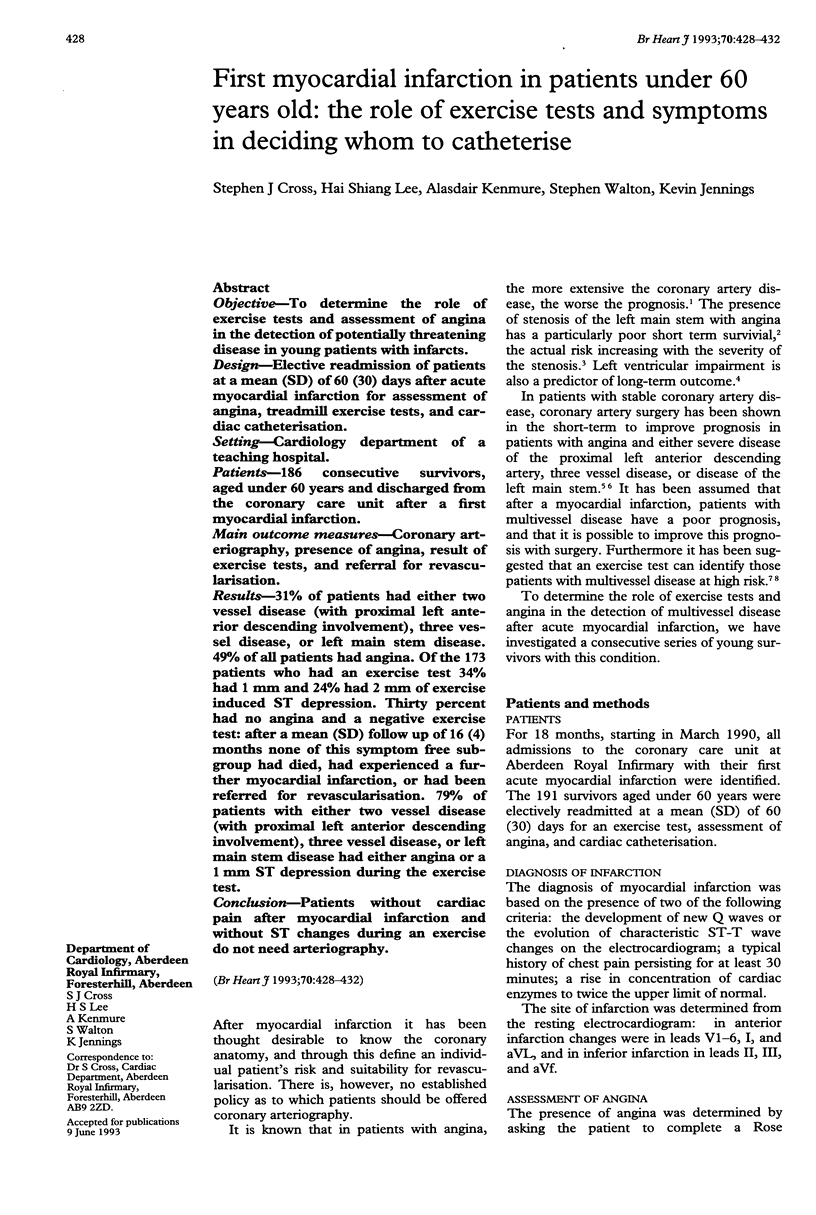
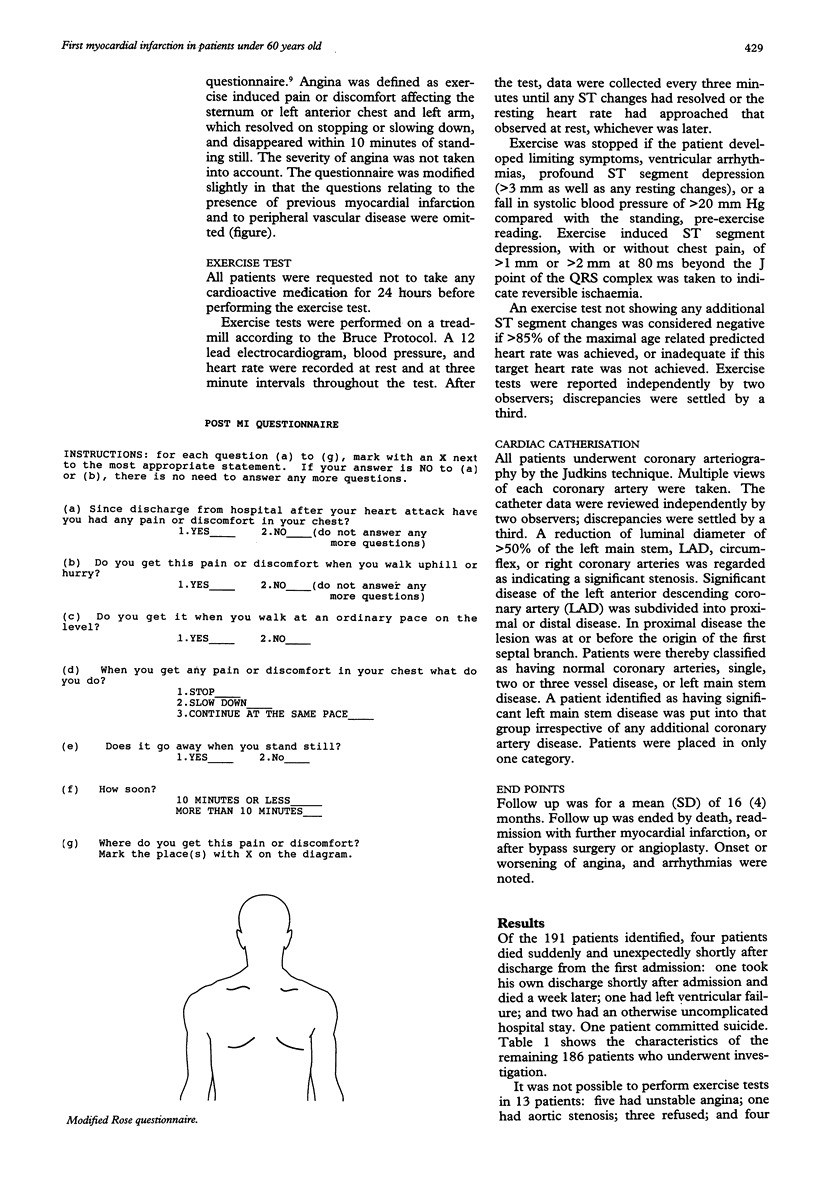
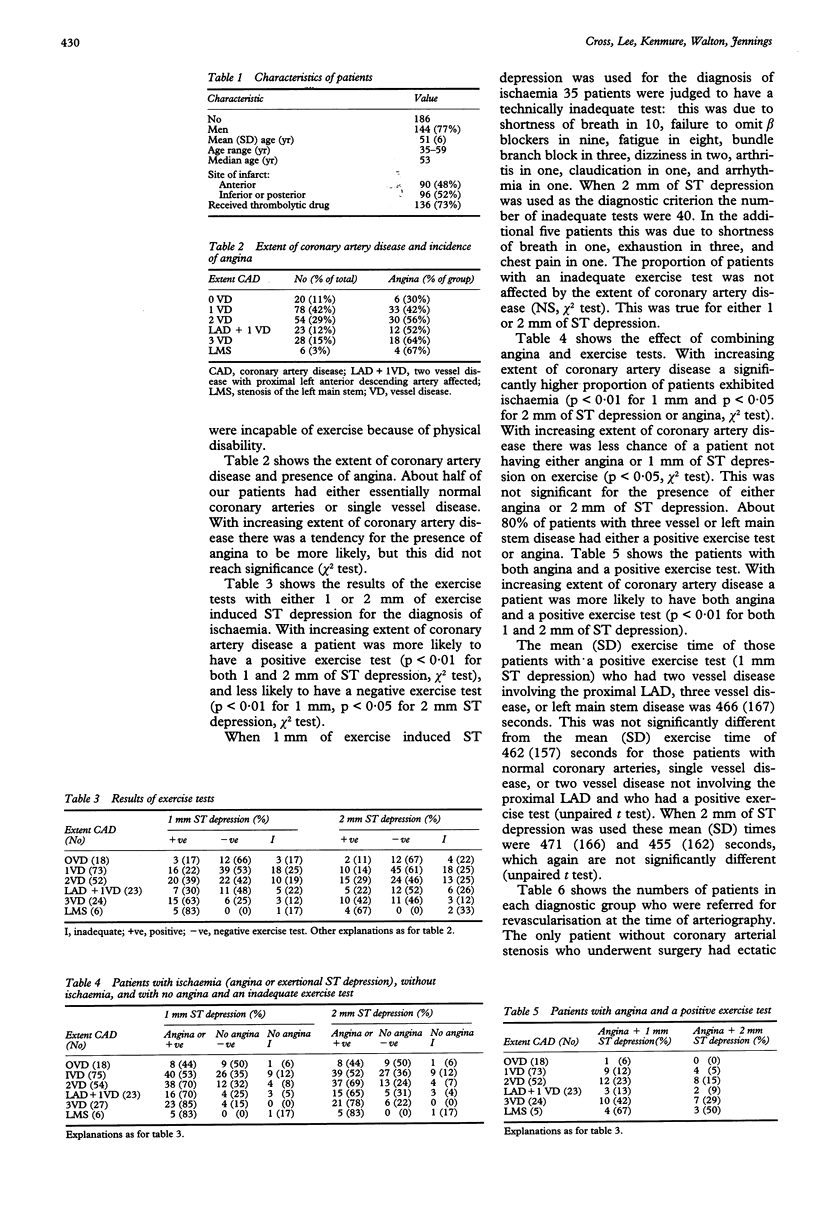
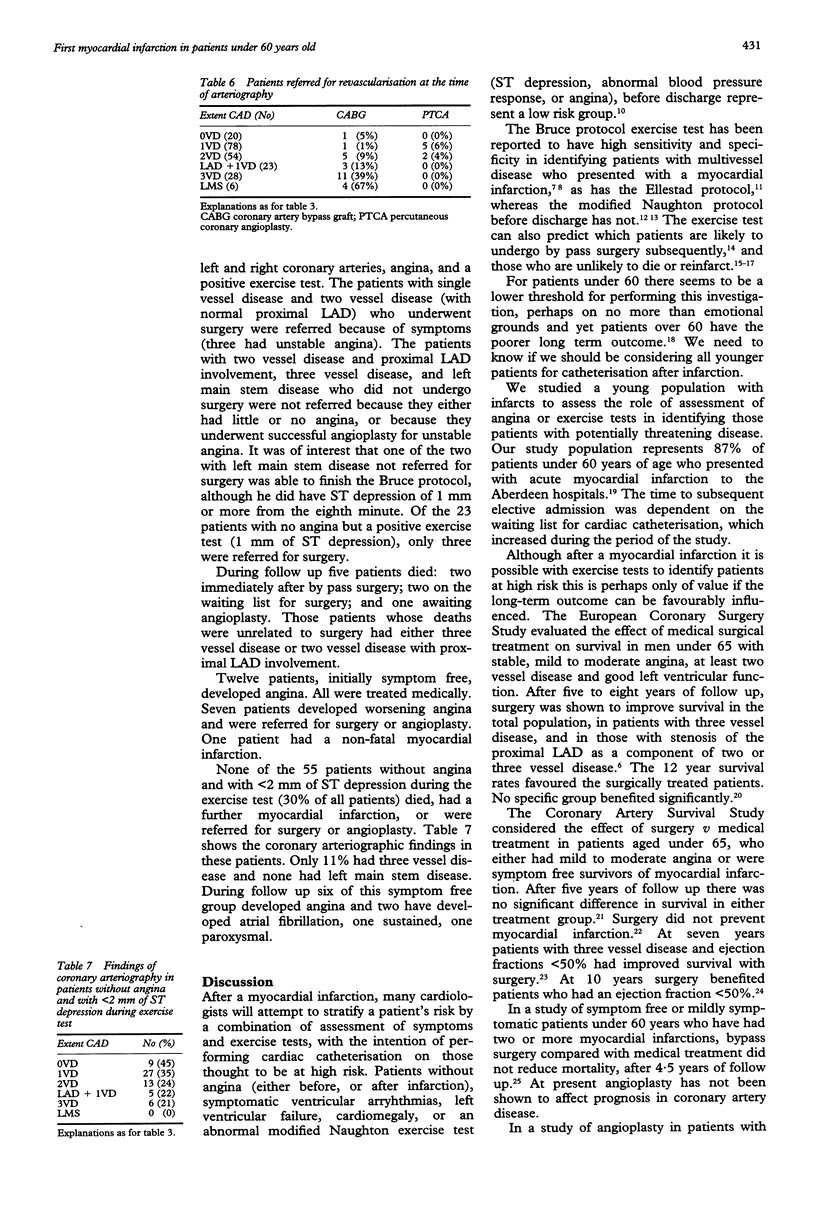
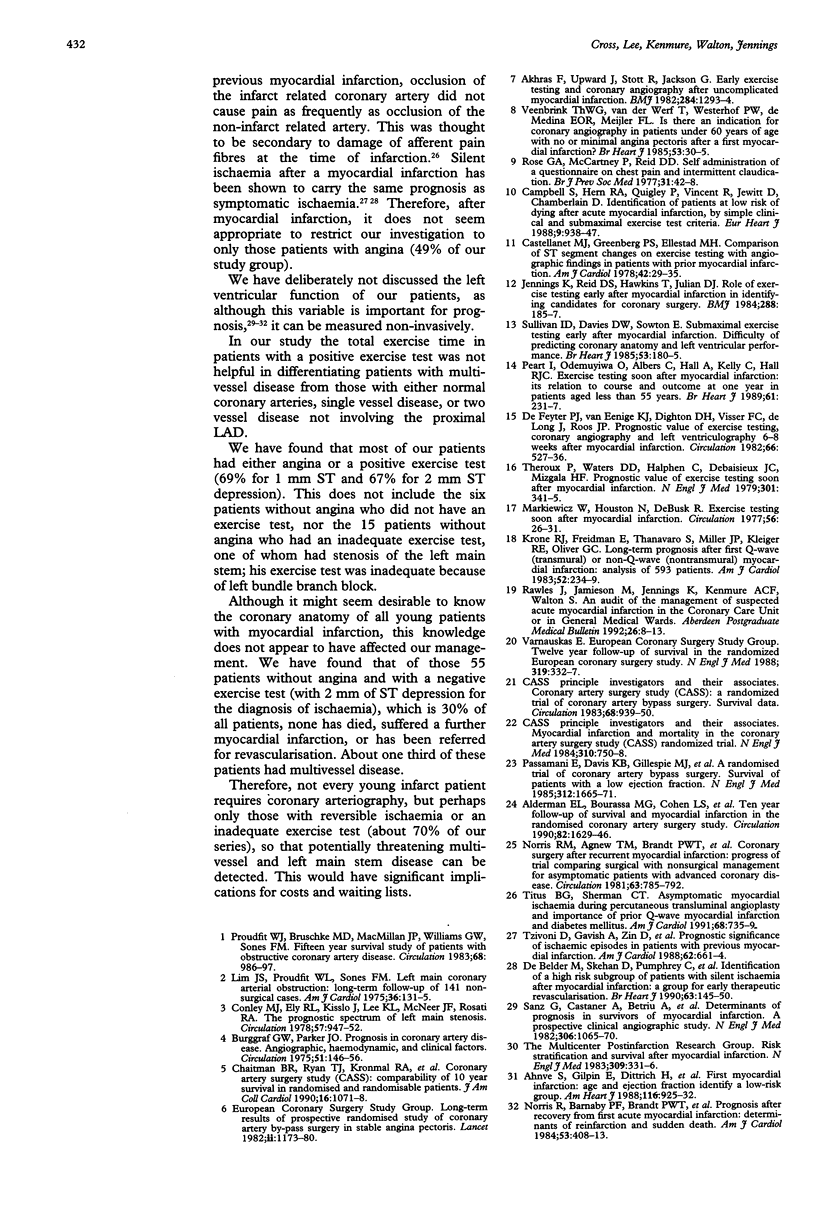
Selected References
These references are in PubMed. This may not be the complete list of references from this article.
- Ahnve S., Gilpin E., Dittrich H., Nicod P., Henning H., Carlisle J., Ross J., Jr First myocardial infarction: age and ejection fraction identify a low-risk group. Am Heart J. 1988 Oct;116(4):925–932. doi: 10.1016/0002-8703(88)90142-1. [DOI] [PubMed] [Google Scholar]
- Akhras F., Upward J., Stott R., Jackson G. Early exercise testing and coronary angiography after uncomplicated myocardial infarction. Br Med J (Clin Res Ed) 1982 May 1;284(6325):1293–1294. doi: 10.1136/bmj.284.6325.1293. [DOI] [PMC free article] [PubMed] [Google Scholar]
- Alderman E. L., Bourassa M. G., Cohen L. S., Davis K. B., Kaiser G. G., Killip T., Mock M. B., Pettinger M., Robertson T. L. Ten-year follow-up of survival and myocardial infarction in the randomized Coronary Artery Surgery Study. Circulation. 1990 Nov;82(5):1629–1646. doi: 10.1161/01.cir.82.5.1629. [DOI] [PubMed] [Google Scholar]
- Burggraf G. W., Parker J. O. Prognosis in coronary artery disease. Angiographic, hemodynamic, and clinical factors. Circulation. 1975 Jan;51(1):146–156. doi: 10.1161/01.cir.51.1.146. [DOI] [PubMed] [Google Scholar]
- Campbell S., A'Hern R., Quigley P., Vincent R., Jewitt D., Chamberlain D. Identification of patients at low risk of dying after acute myocardial infarction, by simple clinical and submaximal exercise test criteria. Eur Heart J. 1988 Sep;9(9):938–947. doi: 10.1093/oxfordjournals.eurheartj.a062598. [DOI] [PubMed] [Google Scholar]
- Castellanet M. J., Greenberg P. S., Ellestad M. H. Comparison of S-T segment changes on exercise testing with angiographic findings in patients with prior myocardial infarction. Am J Cardiol. 1978 Jul;42(1):29–35. doi: 10.1016/0002-9149(78)90980-3. [DOI] [PubMed] [Google Scholar]
- Chaitman B. R., Ryan T. J., Kronmal R. A., Foster E. D., Frommer P. L., Killip T. Coronary Artery Surgery Study (CASS): comparability of 10 year survival in randomized and randomizable patients. J Am Coll Cardiol. 1990 Nov;16(5):1071–1078. doi: 10.1016/0735-1097(90)90534-v. [DOI] [PubMed] [Google Scholar]
- Conley M. J., Ely R. L., Kisslo J., Lee K. L., McNeer J. F., Rosati R. A. The prognostic spectrum of left main stenosis. Circulation. 1978 May;57(5):947–952. doi: 10.1161/01.cir.57.5.947. [DOI] [PubMed] [Google Scholar]
- De Feyter P. J., van Eenige M. J., Dighton D. H., Visser F. C., de Jong J., Roos J. P. Prognostic value of exercise testing, coronary angiography and left ventriculography 6--8 weeks after myocardial infarction. Circulation. 1982 Sep;66(3):527–536. doi: 10.1161/01.cir.66.3.527. [DOI] [PubMed] [Google Scholar]
- Jennings K., Reid D. S., Hawkins T., Julian D. J. Role of exercise testing early after myocardial infarction in identifying candidates for coronary surgery. Br Med J (Clin Res Ed) 1984 Jan 21;288(6412):185–187. doi: 10.1136/bmj.288.6412.185. [DOI] [PMC free article] [PubMed] [Google Scholar]
- Krone R. J., Friedman E., Thanavaro S., Miller J. P., Kleiger R. E., Oliver G. C. Long-term prognosis after first Q-wave (transmural) or non-Q-wave (nontransmural) myocardial infarction: analysis of 593 patients. Am J Cardiol. 1983 Aug;52(3):234–239. doi: 10.1016/0002-9149(83)90114-5. [DOI] [PubMed] [Google Scholar]
- Lim J. S., Proudfit W. L., Sones F. M., Jr Left main coronary arterial obstruction: Long-term follow-up of 141 nonsurgical cases. Am J Cardiol. 1975 Aug;36(2):131–135. doi: 10.1016/0002-9149(75)90515-9. [DOI] [PubMed] [Google Scholar]
- Markiewicz W., Houston N., DeBusk R. F. Exercise testing soon after myocardial infarction. Circulation. 1977 Jul;56(1):26–31. doi: 10.1161/01.cir.56.1.26. [DOI] [PubMed] [Google Scholar]
- Norris R. M., Agnew T. M., Brandt P. W., Graham K. J., Hill D. G., Kerr A. R., Lowe J. B., Roche A. H., Whitlock R. M., Barratt-Boyes B. G. Coronary surgery after recurrent myocardial infarction: progress of a trial comparing surgical with nonsurgical management for asymptomatic patients with advanced coronary disease. Circulation. 1981 Apr;63(4):785–792. doi: 10.1161/01.cir.63.4.785. [DOI] [PubMed] [Google Scholar]
- Norris R. M., Barnaby P. F., Brandt P. W., Geary G. G., Whitlock R. M., Wild C. J., Barratt-Boyes B. G. Prognosis after recovery from first acute myocardial infarction: determinants of reinfarction and sudden death. Am J Cardiol. 1984 Feb 1;53(4):408–413. doi: 10.1016/0002-9149(84)90003-1. [DOI] [PubMed] [Google Scholar]
- Passamani E., Davis K. B., Gillespie M. J., Killip T. A randomized trial of coronary artery bypass surgery. Survival of patients with a low ejection fraction. N Engl J Med. 1985 Jun 27;312(26):1665–1671. doi: 10.1056/NEJM198506273122603. [DOI] [PubMed] [Google Scholar]
- Peart I., Odemuyiwa O., Albers C., Hall A., Kelly C., Hall R. J. Exercise testing soon after myocardial infarction: its relation to course and outcome at one year in patients aged less than 55 years. Br Heart J. 1989 Mar;61(3):231–237. doi: 10.1136/hrt.61.3.231. [DOI] [PMC free article] [PubMed] [Google Scholar]
- Proudfit W. J., Bruschke A. V., MacMillan J. P., Williams G. W., Sones F. M., Jr Fifteen year survival study of patients with obstructive coronary artery disease. Circulation. 1983 Nov;68(5):986–997. doi: 10.1161/01.cir.68.5.986. [DOI] [PubMed] [Google Scholar]
- Rose G., McCartney P., Reid D. D. Self-administration of a questionnaire on chest pain and intermittent claudication. Br J Prev Soc Med. 1977 Mar;31(1):42–48. doi: 10.1136/jech.31.1.42. [DOI] [PMC free article] [PubMed] [Google Scholar]
- Sanz G., Castañer A., Betriu A., Magriña J., Roig E., Coll S., Paré J. C., Navarro-López F. Determinants of prognosis in survivors of myocardial infarction: a prospective clinical angiographic study. N Engl J Med. 1982 May 6;306(18):1065–1070. doi: 10.1056/NEJM198205063061801. [DOI] [PubMed] [Google Scholar]
- Sullivan I. D., Davies D. W., Sowton E. Submaximal exercise testing early after myocardial infarction. Difficulty of predicting coronary anatomy and left ventricular performance. Br Heart J. 1985 Feb;53(2):180–185. doi: 10.1136/hrt.53.2.180. [DOI] [PMC free article] [PubMed] [Google Scholar]
- Théroux P., Waters D. D., Halphen C., Debaisieux J. C., Mizgala H. F. Prognostic value of exercise testing soon after myocardial infarction. N Engl J Med. 1979 Aug 16;301(7):341–345. doi: 10.1056/NEJM197908163010701. [DOI] [PubMed] [Google Scholar]
- Titus B. G., Sherman C. T. Asymptomatic myocardial ischemia during percutaneous transluminal coronary angioplasty and importance of prior Q-wave infarction and diabetes mellitus. Am J Cardiol. 1991 Sep 15;68(8):735–739. doi: 10.1016/0002-9149(91)90645-2. [DOI] [PubMed] [Google Scholar]
- Tzivoni D., Gavish A., Zin D., Gottlieb S., Moriel M., Keren A., Banai S., Stern S. Prognostic significance of ischemic episodes in patients with previous myocardial infarction. Am J Cardiol. 1988 Oct 1;62(10 Pt 1):661–664. doi: 10.1016/0002-9149(88)91198-8. [DOI] [PubMed] [Google Scholar]
- Varnauskas E. Twelve-year follow-up of survival in the randomized European Coronary Surgery Study. N Engl J Med. 1988 Aug 11;319(6):332–337. doi: 10.1056/NEJM198808113190603. [DOI] [PubMed] [Google Scholar]
- Veenbrink T. W., van der Werf T., Westerhof P. W., Robles de Medina E. O., Meijler F. L. Is there an indication for coronary angiography in patients under 60 years of age with no or minimal angina pectoris after a first myocardial infarction? Br Heart J. 1985 Jan;53(1):30–35. doi: 10.1136/hrt.53.1.30. [DOI] [PMC free article] [PubMed] [Google Scholar]
- de Belder M., Skehan D., Pumphrey C., Khan B., Evans S., Rothman M., Mills P. Identification of a high risk subgroup of patients with silent ischaemia after myocardial infarction: a group for early therapeutic revascularisation? Br Heart J. 1990 Mar;63(3):145–150. doi: 10.1136/hrt.63.3.145. [DOI] [PMC free article] [PubMed] [Google Scholar]


